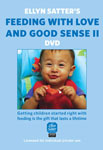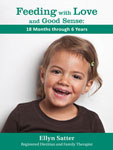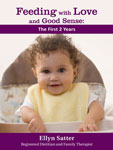
Childhood feeding problems and solutions
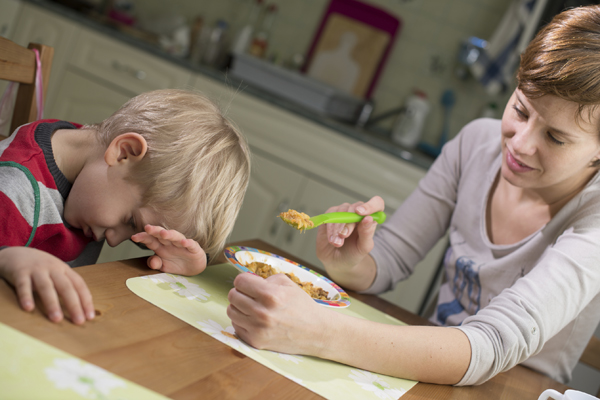
The child who doesn’t eat fruits and vegetables
Parents consider vegetables and fruits tremendously important and feel they have to get their children to eat them. As a result, many children don’t eat vegetables; others don’t eat fruits. Still others don’t eat either. Settle down! Your child will not experience nutritional catastrophe if he doesn’t eat them. If he gets sick, it is from something else.
Relax and enjoy your own fruits and vegetables
- Fruits and vegetables carry the same nutrients, so you and your child can be well-nourished on either.
- Eventually, if you eat them, your child will learn to eat them, too.
- Tone down strong vegetable flavors with salt, fat, sauces, bread crumbs, herbs and spices.
- Tone down fruit textures by making sauces, desserts, using canned rather than fresh.
Pressure doesn’t work – ever
- Your child sees though even sneaky pressure such as bribes, cheer-leading, and your acting like you love them.
- He assumes, ”if they have to do all that to get me to eat it, it can’t be good.”
- What works is minding your own business. Eat and enjoy your own vegetables. Your child assumes, “someday I will eat them too.”
How to parent so your child eats fruits and vegetables
- Follow the division of responsibility in feeding. Do your jobs with feeding and let your child do his with eating.
- Get started with family meals, if you aren’t having them already.
- Observe how your child learns to eat unfamiliar food. He watches you eat it but doesn’t eat; he helps you cook and garden but doesn’t eat; he puts it in his mouth and takes it out again.
- Hang in for the long haul. Food may show up at mealtime 15 or 20 times before your child eats it.
- Stop counting. It could take years. Enjoy your own food!

The picky eater
All young children are more-or-less picky about food and refuse new foods at first. To them, all foods are new, and it takes time and experience for them to learn to eat them. The problem is when they get stuck with being picky. Maintain the Satter Division of Responsibility in Feeding (sDOR) and adjust your expectations! Avoid pressure, be considerate without catering with meal-planning, and don’t hold your breath! Your job is to provide your child with repeated neutal exposure to food: seeing it over and over again with no pressure. That allows her to gradually sneak up on it: look, watch you and others eat it, allow a bit on her plate, touch it . . . you get the idea. The goal is for your child to be relaxed and comfortable at mealtime and around food in general. If you achieve that, sooner or later (it could be months or even years later) she will eat almost everything that you eat.
Is your child stuck with being picky?
- Does she get upset when she sees unfamiliar food?
- Does she only, ever, eat her few and ever-shrinking list of favorite foods?
- Does she worry she will be unable to eat away from home?
- Do you make special food for her in order to get her to eat?
- Are you upset about her eating?
Follow sDOR so you child can please you – and please herself
- Have regular meals and sit-down snacks so your child can be hungry but not starved at mealtime. Don’t let her eat or drink (except for water) between times.
- Don’t ask the child what she wants to eat, but do be considerate without catering with meal planning. Include 1 or 2 side-dish foods she usually eats. Don’t make special food for her.
- Tell her, “you don’t have to eat,” and show her you mean it. Let her eat what she wants to eat from the meal and ignore the rest.
- Don’t pressure her in any way to eat. Don’t bribe, encourage, cheer-lead, reward, force, glare, punish, deprive, deceive, make a big deal of loving the food, talk about her food likes and dislikes.
- Make meals a pleasure and a privilege. Tell her, “you do have to behave at mealtime. Say ‘yes please’ and ‘no thanks.’ No whining, asking for special food, or saying ‘yuk.’” Show her you mean it.
What will happen next
If you stop worrying about what your child eats, you can both enjoy family meals. Parents say their children are happier and more relaxed not only at mealtimes but at other times, as well.
- First, you will become consistent about having structured meals and snacks.
- For a while your child will test the mealtime rules.
- Then she will settle down and behave well.
- She will get repeated neutal exposure to the food you and others eat.
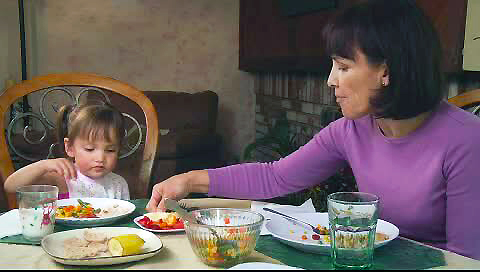
The child who eats “too little”
All children know how much they need to eat in order to grow in the way nature intended for them. Why do you think your child doesn’t eat enough? Does he eat less than other children? Is he smaller than other children? Do you continually try to get him to eat or drink, and feel grateful when he does?
Chances are, there is no problem
- Some children don’t eat much, others eat a lot.
- Some children who eat a lot are still small and slim.
- Some children are just small, others are just big.
Evaluate your child’s growth
- As long as his weight follows near the same percentile, he is growing well.
- But if his weight percentiles go down a lot over a short time, he may be getting too thin.
Feed as if you weren’t worried about his weight
- Don’t let him have food or drinks between times, except for water. Food handouts will make him eat less, not more.
- Maintain a division of responsibility in feeding, keep your nerve, and let him eat and grow his way. Do not get pushy with food.
- Get started with family meals, if you aren’t having them already. Feed in the best way for his stage of development.
- Have your child join in with family meals and sit-down snacks at set times. Have the same meal for everyone.
- Include high-fat food, such as butter, salad dressing, and mayonnaise, but don’t try to get your child to load up on it or any other food.
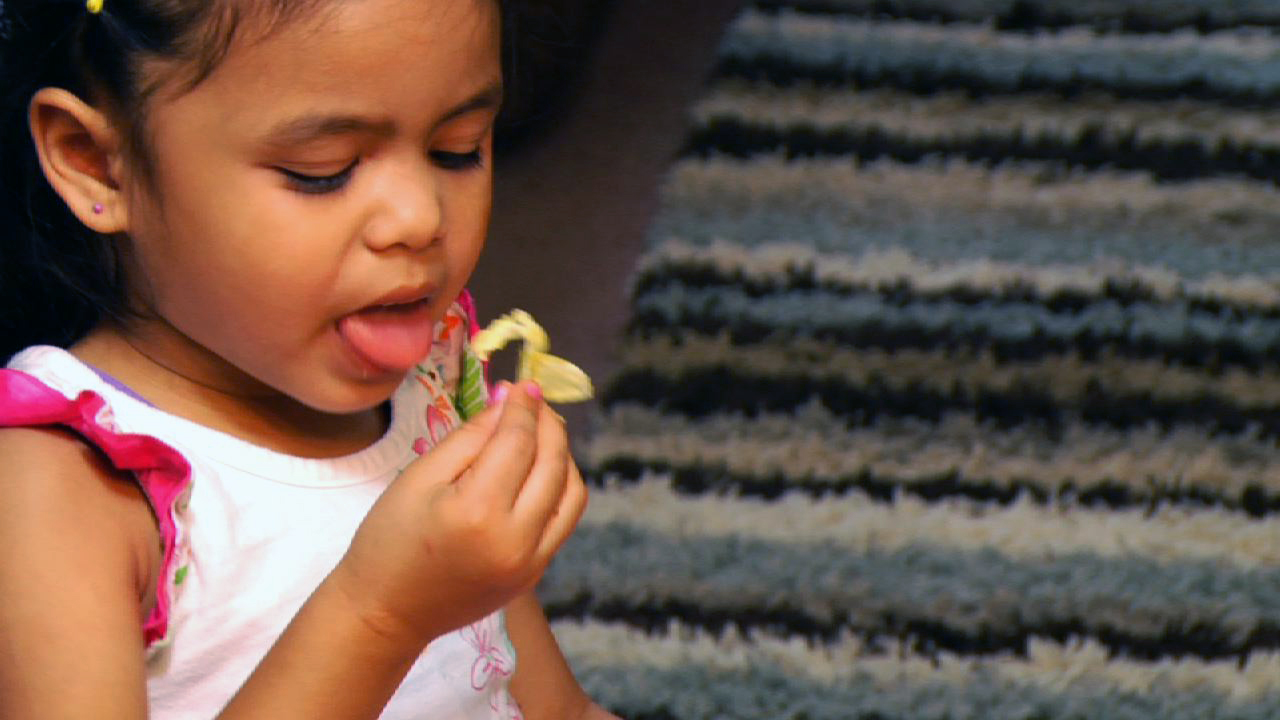
The child who eats “too much”
Children only eat too much when they are afraid of going hungry. When you follow a division of responsibility in feeding, your child will eat as much as she needs in order to grow in the way nature intended for her. As long as her weight follows close to the same percentile on the growth curve, she is growing well. There could be a problem if her weight percentiles go up a lot over a short time, but the solution is the same: Do an excellent job with feeding.
Don’t be spooked by your child’s eating and weight
- Some babies and children eat a lot and love to eat: they still know how much they need to eat.
- From birth, some children are just normally big. As long as their growth is consistent, that is okay.
- Some big babies and children don’t eat much: they are satisfied on less food and continue to weigh what they weight.
Feed as if you weren’t worried about her weight
- Feed on demand from birth. Introduce solid food when she is ready. Follow her cues to determine when and how much to feed.
- Get started with family meals, if you aren’t having them already. Toward the end of her first year, she is likely to be ready to join in.
- Have family meals and sit-down snacks at set times. Don’t let her have food or drinks between times, except for water.
- Have the same meal for everyone. Include high-fat and low-fat food.
- Include ”forbidden” foods at meals and snacks. Trying to restrict those foods will make her eat more of them in the long run.
Your child will feel hurt, get scared, and genuinely eat too much if you . . .
- Try to get her to eat less than she wants.
- Restrict either amounts or types of food. Control her portion size. Push low-calorie food.
- Feed her differently from other family members.
- Give her the look when she seems to eat a lot.
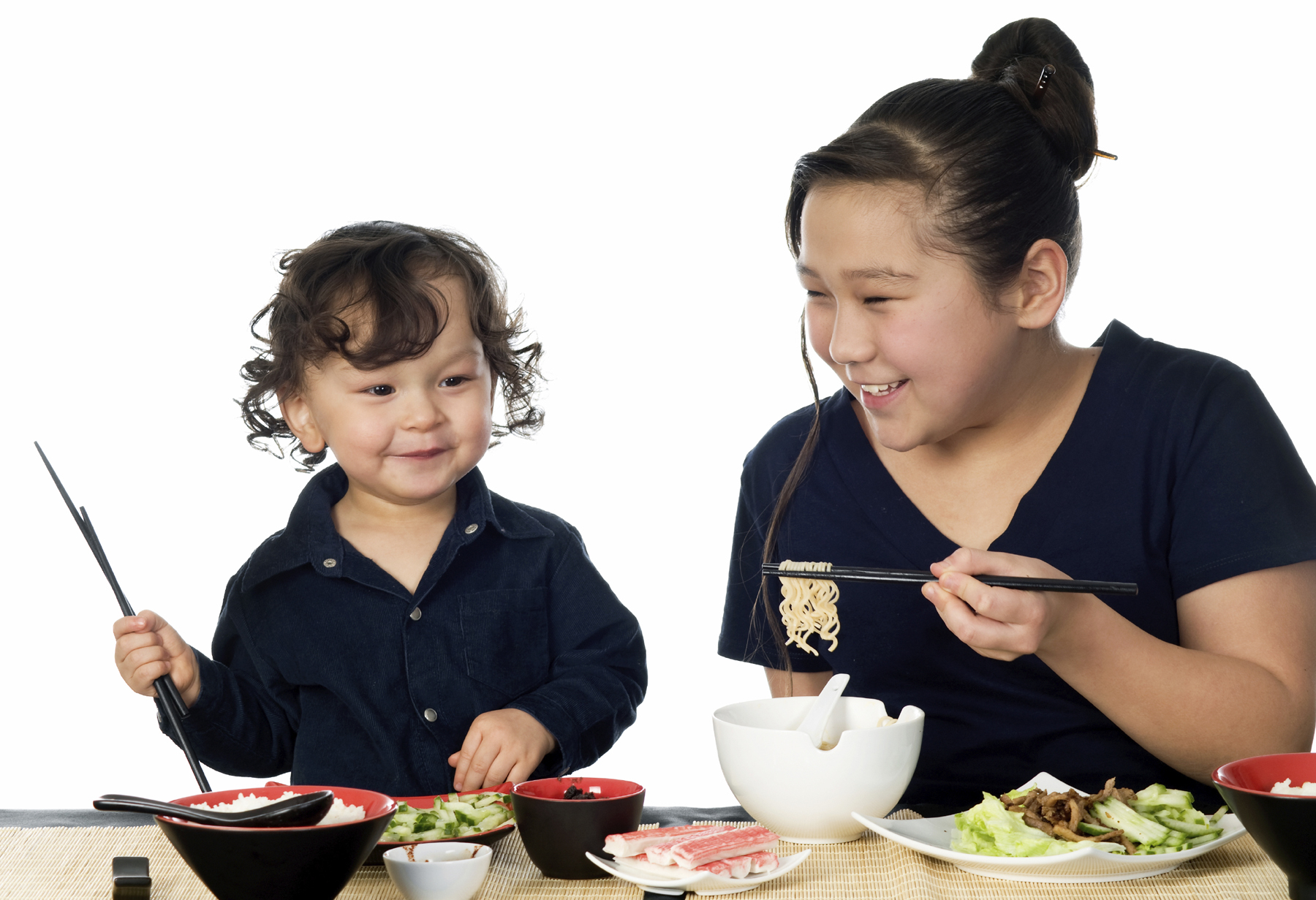
The “underweight” child
Your child’s weight is likely to be normal if it follows along a particular percentile curve, even if it is below the 5th or 3rd percentile on the growth chart. But if his weight falters – if it drops quickly across several growth percentiles – it is likely to indicate a problem.
Feeding errors can make your child gain too little weight
- Too much interference. Parents of small children often try to get them to eat more than they want. However, such pressure makes children eat less, not more.
- Too little structure. Parents of small children often let them eat all the time and are grateful when they do. However, such tactics make children eat less and not more.
- Both together. Depending on how desperate they are, parents may do both – let children eat all the time and pressure them to eat when there happens to be a meal. That is seriously hard on everyone and really doesn’t work.
Feed in the best way
- Maintain a division of responsibility in feeding. Do your feeding jobs and let your child do his eating jobs.
- Get started with family meals, if you aren’t having them already. Give sit-down snacks between times.
- Don’t let your child have food or drinks between times, except for water. Food handouts will make him eat less, not more.
- Have the same meal for everyone. Include high-fat food, such as butter, salad dressing, and mayonnaise, but don’t push high-fat food.
- Make wise use of “forbidden foods.”

The “overweight” child
Don’t let anyone tell you or your child that he is overweight. Studies show that children whose parents see them as being too fat grow up to be fatter than those whose parents don’t have such concerns. Parents try to restrict food, and the child does the same when he gets older – or does the opposite and sneaks food. Some grownups try to slim their child down with extra activity. It, too, backfires. The child eats more when he can, gets turned off to activity, and gains more weight than he would otherwise. Instead, do an excellent job with feeding and parenting, correct feeding errors, and let your child grow in the way that is right for him.
Feed and parent in the best way
- Maintain a division of responsibility in feeding and in activity. Do your feeding and parenting jobs and let your child do his.
- By the end of the first year, include your child in family meals. Have the same meal for everyone. Give sit-down snacks. Don’t let him have food or drink handouts between times, except for water.
- Include “forbidden foods” in meals and snacks. Depriving your child will make him eat a lot of them when he gets the chance.
- Teach your child to cope. Help him develop good character, common sense, effective ways of responding to feelings, problem-solving skills, and the ability to get along with others.
Correct feeding errors
- Interference. It is natural to try to get the large child to eat less than he wants. However, trying to do that makes children eat more, not less.
- Lack of structure. Children who can’t depend on getting fed feel constantly hungry, beg for food, and eat as much as they can whenever they can.
- Trying to get your child to eat or grow in a certain way. Even if he is above the 95th percentile, and even if your weight is high, if he grows consistently, he is growing well.
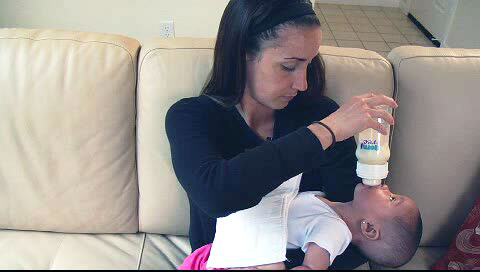
Avoid pressure
Instead of putting pressure on your child’s eating, follow the division of responsibility in feeding.
Pressure on children’s eating always backfires
- Trying to get a child to eat more than she wants makes her eat less.
- Trying to get her to eat less than she wants makes her eat more.
- Trying to get her to eat certain foods makes her avoid them.
- Trying to get her to be neat and tidy makes her messy.
- Putting up with negative behavior in hopes she will eat makes her behave badly but not eat.
What does pressure on eating look like?
- Pressure can seem positive: Praising, reminding, bribing, rewarding, applauding, playing games, talking about nutrition, giving stickers, going on and on about how great the food is, making special food, serving vegetables first, making food fun (to get the child to eat, not just to have fun).
- Pressure can be negative: Restricting amounts or types of food, coaxing, punishing, shaming, criticizing, begging, withholding dessert, treats, or fun activities, physically forcing, threatening.
- Pressure can seem like good parenting: Insisting on “no thank you” bites, encouraging or reminding the child to eat, taste, smell or lick, making her eat her vegetables, warning her that she will be hungry, making special food, keeping after her to use her silverware or napkin, hiding vegetables in other foods, letting her eat whenever she wants to between meals.
- Pressure can be hard to detect: Ask yourself why you are doing something with feeding. Is it to get your child to eat more, less or different food than he does on his own? If so, it is pressure.
back to top

Evitando la Presión
For English, click here.
Presionar a los niños siempre tiene consecuencias negativas. Este consciente de que todos los niños son mas o menos especiales para comer ciertos alimentos. Tratar de hacer que una niña coma mas de lo que quiere hace que coma menos. Tratar de hacer que ella coma menos de lo que quiere la hace comer mas. Hacerla que coma ciertos alimentos hace que ella los evite. Tratar de que ella coma sin ensuciarse y con cuidado hace que haga un tiradero al comer. Tolerar comportamiento negativo con la esperanza de que ella va a comer mas hace que ella se porte mal y no coma.
- La Presión puede parecer positiva: Halagar, recordar, premiar, aplaudir, jugar juegos, hablar sobre nutrición, darle calcomanías, hablar y hablar sobre que tan buena es la comida, preparar comida especial.
- La Presión puede ser negativa: Restringir la cantidad o tipo de alimentos, convencer, insistir, avergonzar, criticar, rogar, no darle postre, dulces, o actividades divertidas, forzar físicamente, amenazar.
- La Presión puede parecer como que los padres son buenos: Animar o recordarle que tiene que comer, probar, oler, o probar con la lengua nada mas, hacerla que coma las verduras, advertirle que ella va a tener hambre después, preparar comida especial, decirle constantemente que use los utensilios o servilleta, esconder las verduras en otros alimentos, dejarla que coma siempre que quiera entre comidas.
- La Presión puede ser difícil de detectar: Pregúntese por que está usted haciendo algo con la alimentación ¿Es para que su niño coma más, menos o algún alimento diferente que lo que él come solo? Si es así, es presión.
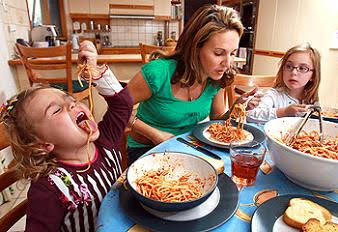
Avoid restriction
Trying to get your child to eat less backfires. Unless we spoil it, children are good at knowing how much they need to eat. Some days they don’t eat much; other days they eat more than you can ever imagine. Instead of restricting your child’s food intake, follow a division of responsibility in feeding. Then ask yourself, “am I doing this because I am worried about his weight?” If the answer is “yes,” don’t do it.
Don’t try to influence how much your child eats
- He will stop knowing how much he needs to eat and eat more than he needs or even wants.
- Even if he tries to please you and eat less, he won’t be able to help himself.
- He will sneak food or eat a lot when he gets the chance.
Avoid these sneaky ways of trying to get your child to eat less
- Dishing up his plate rather than letting him serve himself. Controlling portion sizes. Banning second helpings. Giving him “the look” when he eats a lot.
- Making him eat vegetables or finish them before he can have firsts or seconds of other foods.
- Running out of foods he really likes and might eat a lot of. Running out of food, period.
- Mostly buying and fixing diet or low-calorie foods. Banning or hardly ever allowing sweets or high-fat food.
- Having only “healthy” foods and doing “healthy” cooking: low fat, high-fiber, heavy on the fruits and vegetables, low in sugar.

